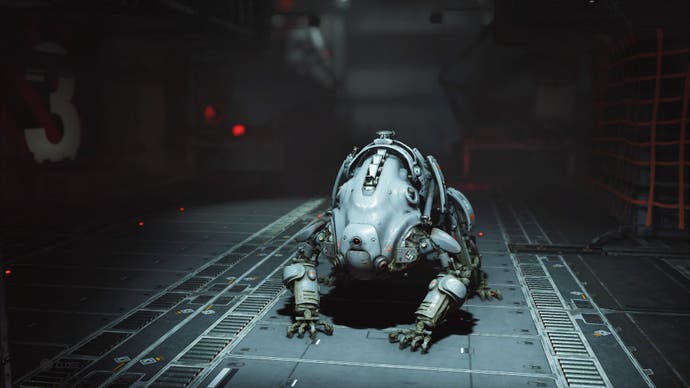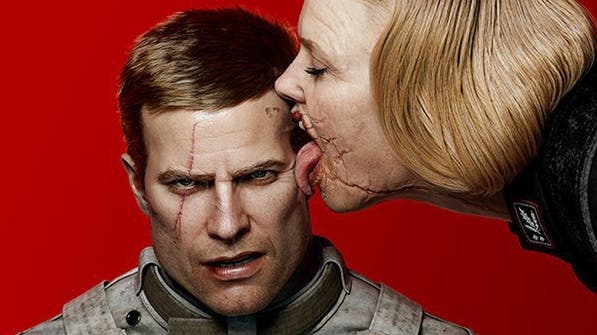The rights and wrongs of Wolfenstein 2: The New Colossus
"It's a struggle every game has..."
Wolfenstein 2: The New Colossus was a rip-roaring science-fiction romp through an alternate history. It was, as Edwin more eloquently said in his Wolfenstein 2 review, "vicious, affecting, witty, spaced-out, crude, inventive, morbid and for the most part, a success."
But while we all merrily mashed Nazis in 1960s America, developers at MachineGames cringed at a parade of things we didn't see - the "I"s which weren't dotted, the "T"s uncrossed. Andreas Öjerfors was one such developer, the senior game designer for Wolfenstein 2, and in a talk at Digital Dragons 2018 in Poland last week he outlined what he thought went well, and what he thought didn't.
Take stealth, for instance. The idea was for Wolfenstein 2 to cater to three playstyles: mayhem, tactical and stealth. The first two were fine but stealth was weak. "Sometimes it felt inconsistent," Öjerfors said in his talk. Enemies discovered you too easily and too often, and you'd be left with no choice but to fight. "We didn't spend enough resources and attention on stealth." He thinks it's because not enough people believed in stealth across the company so it didn't have the creative buy-in it needed to really work.
Or consider the Sturmgewehr, the assault rifle. It's the best weapon in the game, according to Öjerfors - great at range, great up close, there's loads of ammo and, when you start upgrading the gun, there's no need to ever use anything else. Great! But what about all of the other guns now gathering dust? Using more tools is more fun, Öjerfors said.
Then there's the Laserhund [not the Panzerhund, Öjerfors has corrected me - sorry!], a frustratingly fast and solid dog robot with a very powerful laser beam. Öjerfors admitted it was "probably the least enjoyable enemy in the game". This is because the Laserhund didn't spend time in pre-production iteration. Instead, it was built onto the Kampfhund enemy during production. "The idea was to add some features on top," Öjerfors said, "but that never works - there's always some stuff that has to be rebuilt."

Fortunately there wasn't, however, a London Monitor - the Wolfenstein 1 boss as big a skyscraper. No one really liked it, not players, not MachineGames. It might have been visually impressive but it wasn't fun - it was bloody annoying - to fight. "We were never really happy with London Monitor battle," Öjerfors said. "Having such a big enemy and making fun gameplay is just very difficult, so we just stayed away from doing enemies like that this time around."
Communicating with the player was still an issue. Did you know the Supersoldaten (super soldier) in Wolfenstein 1 had more weak points than the unprotected head? Lots of enemies did. You could shoot off armour pieces and target weak points underneath. "But people just don't know that," Öjerfors said. "This was not well communicated."
Communication was better in Wolfenstein 2 - the super soldier backpacks were more obvious weak points - but could be better still. "It's a struggle every game has," Öjerfors told me in an interview afterwards. "Communicating with the player is probably the most difficult part of being a game designer; trying to make the player understand what the player must without feeling like they're being told to do things... You need to communicate silently through cues and that's really difficult."
They're all areas which could be improved for a third Wolfenstein game, which brings us neatly to the question of 'will there be?' - as if Bethesda would be silly enough to let a developer loose at a conference who would simply answer "yes". Nevertheless, there's hope.
When I asked whether it was time for MachineGames to leave hero BJ Blazkowicz be, and stop rebuilding him as if it were the mean boy next door in Toy Story, Öjerfors faltered: "I can't really answer that without talking about what we're doing."
He was asked a similar question during his Wolfenstein 2 postmortem talk - a question about what MachineGames would change in a third instalment. "I can't tell you that!" he said with a laugh. "That's something we would save for E3 two years into the future if we were doing that."
But if MachineGames were doing Wolfenstein 3, Öjerfors would like to give more freedom to players, both in where players can go and what we can do. "Play freedom is for me, personally as a player and a developer, really interesting," he said. "I personally want to continue going down that route."
He would also like to "play with the format a bit", whatever that means. "Not because it's necessary but because we would like to do something different," he said. "This is now our third Wolfenstein game [by which he probably means The New Order, expansion Old Blood, and The New Colossus]. If we would continue down that route [Wolfenstein 3] we would play with the format a bit, do something that would interest us."
Which isn't to suggest Bethesda would be forcing a third game out of MachineGames. Actually, Öjerfors was full of praise for his studio's owner, which I suppose he would be, but I didn't detect he was being insincere.
"That's the great thing about working with Bethesda," he said. "It's not cynical in we have to make the most commercially viable product. Bethesda believes if you make a great game, it will sell, and we believe in that.
"I mean, we don't get rich from making the games so we do it because we really want to. As long as it's a product that can sell, we look at what we like; we tell the stories we tell because we want to, we create the type of gameplay we want because that's what we like, that's what we're interested in."
Rest assured, 'playing with the format' does not mean ditching first-person shooters - in this, MachineGames is resolute. "We are a first-person shooter studio," Öjerfors told me - "that's one of the core values and ambitions of MachineGames. Whatever we do, even if we did Tetris 2, Tetris 2 would be a first-person shooter."
Where MachineGames could take a theoretical Wolfenstein 3 in the future is a juicy question to ponder. Wolfenstein: The New Order took place all over Europe in the 1960s, and The New Colossus was set in America not long after. Where next? When next?
Wherever and whenever it goes, Wolfenstein's subject matter - however far-fetched - is likely to remain disappointingly close to the political bone. Wolfenstein 2 provoked the ire of the far-right with marketing slogans such as "Make America Nazi-Free Again" and "#NoMoreNazis". It's a controversy Öjerfors (and Bethesda publicly before him) has no time for.
"If we get negative feedback from Nazis and racists, we don't really care," he told me. "If it's a statement today to say Nazis are bad then we are in a lot of trouble as a civilisation.
"We didn't go into this intending to be controversial at all," he added. "What we were saying was something everyone has said since the late 1940s. That it is at all controversial today is just sad.
"Reasonable people understand what we do," he concluded, "and that's who we make the game for."
Incidentally, Wolfenstein 2: The New Colossus comes to Switch one month from now - 29th June 2018.



